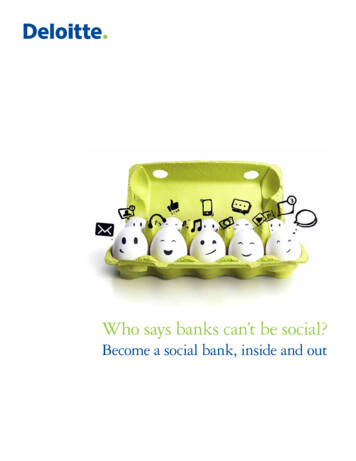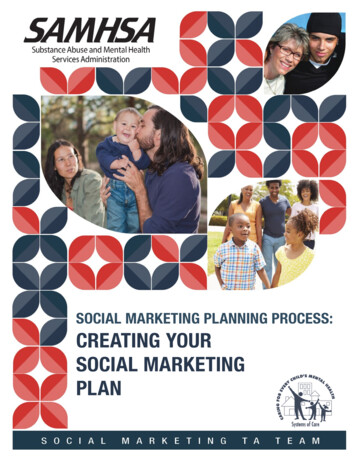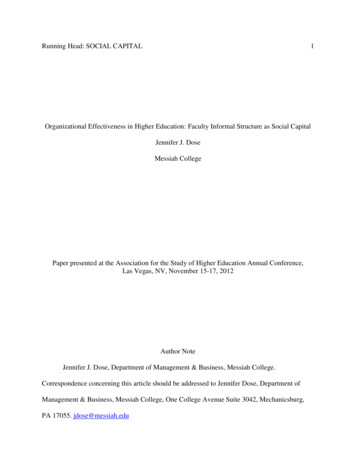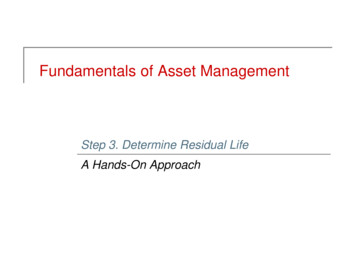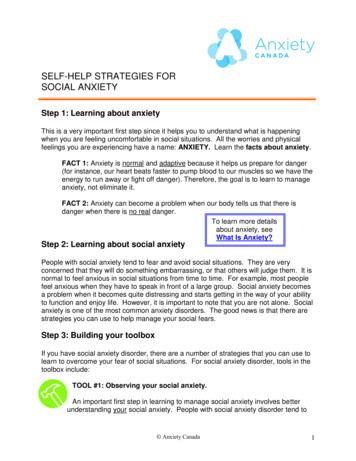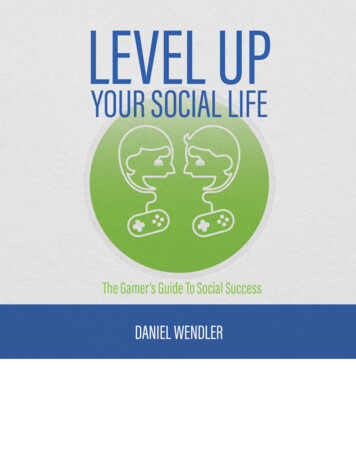
Transcription
Level Up Your Social Life: A Gamer’s Guide To Social SuccessBy Daniel Wendler, ImproveYourSocialSkills.comExcerpt (Stage one only). Buy the whole book on Amazon.comIf you are afraid, come forth.If you are alone, come forth now.Everybody here has loved and lostSo level up and love againCall it any name you need.Call it your 2.0, your rebirth, whatever-So long as you can feel it all,So long as all your doors are flung wide.Call it your day #1 in the rest of forever.If you are afraidGive moreIf you are aliveGive more nowEverybody here has seams and scarsSo what. LEVEL UP.- Vienna Teng, Level Up, from the album Aims 2013 Soltruna Music www.viennateng.comHow To Use This BookI know you’re anxious to jump into the guide itself, but take two minutes to read this section first.Everything will make much more sense if you do.This guide is organized into three stages. Each stage has seven levels, and each level has one main questand three side quests. (There are also some bonus appendixes because everyone likes bonuses.)The StagesThe stages divide the book into three different section, each focusing on a different goal. The stages arean easy way of tracking your progress, as well as telling you the “big idea” I’m trying to address in eachpart of the book.The first stage, “Character Creation” focuses on changing your habits and routines. You’ll be changingyour life in little ways – like being more social, more open to experience, and more willing to take risks.The goal is to make you more naturally social, by making social connection part of your everyday life.
The second stage, “Multiplayer” is all about conversation skills. You’ll learn how to have successfulconversations, how to read body language, and how to connect with others.The third stage, “Looking For Group”, is about building friendships and going deeper with friends. Thefocus here is on building in-depth relationships – making new friends, getting closer with the friends thatyou’ve got, and feeling more connected with others.The stages are designed to be completed in order. Character Creation prepares you for Multiplayer,which prepares you to succeed when you start Looking For Group.LevelsLevels are basically mini-chapters. In each level, I’ll talk about how a concept from gaming can help youimprove your social life. Then I’ll give you a main quest and some side quests to help you practice whatyou learned.Main QuestsEach level has a main quest for you to complete. Quests are a way for you to apply ideas from the bookto your life. Much as you complete quests in RPGs to make your character more powerful, you’llcomplete these quests to make yourself more social.Each quest includes: The quest objectives (what you do)The quest description (how you do it)The quest rewards (why you should do it.)There are three kinds of quests. Collection Quests: Do something a certain number of times.Daily Quests: Do something once a day for a week.Weekly Quests: Do something once a week for a month.Feel free to tweak this if you want. If once a week seems too difficult, try every other week. If you wantfaster progress, try twice a week. If you really like a quest, do it over and over.The most important thing is to pick a pace that you can stick with. The goal is to move fast enough thatyou’re making progress, but slow enough that you don’t feel overwhelmed.Side QuestsEach level has three side quests. Side quests are bonus challenges, and each one is different. They mightgive you an extra opportunity to practice, make the main quest more challenging, or introduce you tothe games I talk about in the level. Side quests are totally optional, but you’ll get more out of the guide ifyou do them. I recommend doing at least one per level, and it’s great if you can do all three.AppendixesAt the end of the book are three appendixes: Cheat Codes, Achievements, and Game Directory. CheatCodes has quick tips and tricks that you can use in social settings, Achievements are tongue-in-cheek
awards for using this book, and Game Directory shows you where you can play every game I mention inthis book.Quest Strategy GuideIn some video games you can level up just by reading a book, but real life doesn’t work that way. In reallife, you need to practice if you want to get better at something.That’s what the quests are for. The more quests you complete, the faster you’ll reach your social goals.But be careful. If you start too many quests at once, you’ll be overwhelmed. If you start quests tooslowly, you won’t make much progress.To strike the right balance, I recommend the following strategy: Start a new collection quest when you finish the last collection questStart a new daily quest each weekStart a new weekly quest every other week (so you should have two active each month.)In other words, you should usually be working on one collection quest, one daily quest, and two weeklyquests at a time. That’s four quests total, which is challenging but doable.Of course, this is just a rule of thumb. You might find that you prefer to do more or less at a time. Or youmight find that you can do a lot of easy quests at once, but need to slow down when a hard quest comesalong. If you feel challenged but confident you can handle it, you’re probably doing the right amount.Basically, think of it like the difficulty setting on a video game – if you’re getting creamed, make it easier.If you’re sailing through without a challenge, make it harder.You should also try to track your quest progress. It’s a hassle, but If you track your progress, you’re muchmore likely to succeed. A few options for tracking quests: Pen and paper (especially if you tape it up somewhere you see it every day)A spreadsheetTodoist.comHabitRPG.comI recommend setting aside a certain time each day for updating your quest progress. For instance, youmight give yourself five minutes during breakfast or dinner to review your current quests, update yourprogress, and perhaps re-read a tip from the guide. This might sound like a lot of work, but once itbecomes a habit it will feel effortless. Plus, daily checkups will make you much more likely to successwith your social goals.Stage One: Character CreationLevel One: Press StartThis is not going to be easy.
I’m going to ask you to change. I’m going to ask you to grow. I’m going to ask you to fail, again and againuntil you learn to succeed.But I promise you, it will be worth it.It was for me.When I was growing up, I was the nerdiest, most awkward kid you could ever hope to meet. My comfortzone began and ended with my Super Nintendo, and my social abilities were limited to 1) talking aboutStar Wars 2) talking about video games and 3) talking about Star Wars video games.In high school, I was diagnosed with Asperger’s syndrome, a condition that makes it much harder for meto learn social skills naturally. So I decided to learn them deliberately, like I was studying a foreignlanguage. At that point, it was about survival more than anything. I just wanted to stop the teasing.But I was dreaming too small.Learning how to be social is far, far more than avoiding bullies. It’s about giving your life more meaning.The memories that matter the most to me are not boss battles or high scores. They’re memories ofpeople. I remember late night conversations, dinners with a table full of friends, and incredible datesthat ended with kisses in the rain.I think everyone deserves those kinds of memories. I think everyone deserves a place where theybelong, close friends who know them deeply, and the confidence to put their best foot forward in newsocial settings.And I wrote this guide to help you get there.Here’s what I need you to doQuest 1.1 (Type: Daily)Quest Objectives Open the book every day this week.Yes, that’s really it.Quest Description:Most people quit.This quest is about making sure that you don’t.Here’s the thing. Being more social is not rocket science, and it’s not magic. Like most skills, if you workat it a little bit every day, over time you will get a lot better. The key is just making sure that you work atit a little bit every day – without giving up!So here’s your quest.Open this book tomorrow, and then keep opening it every day for a week. You can read it for fiveminutes. You can read it for an hour. You can even just skim the table of contents if you really want
Here’s why. If you want to succeed socially, you need consistency. You need to let social growth be aregular part of your daily life. Most MMOs keep user interest with daily quests – you’ve got to log in atleast for a few minutes to finish the daily quests. You need to have the same kind of consistency withyour social life.Obviously, it’s not the end of the world if you skip a day. But if that skipped day turns into a skippedweek and then a skipped month, you’re in trouble. That’s why it’s so important for you to practiceconsistency.So your first quest is simple: Read this book every day this week. Of course, you can keep reading today.But I want you to commit that you’ll pick up the book for the rest of the week too. Think you’re up tothe challenge?Quest Reward: A higher chance of completing the bookBetter odds of achieving social successThe rest of the book is super cool and you don’t want to miss out.Side Quests: Raise the Stakes. Get seven five dollar bills, and stick them somewhere out of the way. Every daythat you pick up this book, grab one of the five-dollar bills and use it to treat yourself tosomething fun. Every day you don’t read, grab a bill and make a 5 donation to charity – or ifyou really want to motivate yourself, just shred it.Write Down Three Concrete, Vivid Goals. Imagine three specific, vivid goals, and write themdown. Don’t pick abstract ideas like “I want to be more social.” Choose goals like “I want to beable to start a conversation with someone else and have it go well” or “I want to host a movienight for at least three other people.”Schedule Time To Read. Choose a specific time tomorrow when you’ll pick up the guide again –and set a reminder!Level Two: Random EncountersOne of the most enduring tropes of RPGs is the random encounter. Want to make your characterstronger? Walk outside of town until you run into a random monster, bash the monster over the headuntil it falls over, and then move on to the next monster.The implications of random encounters don’t make much sense (how does anyone get anything donewhen monsters attack them every ten steps?) But the basic logic is sound: If your character does a lot oflittle fights, they’ll be prepared to handle the big boss fight when it rolls around.And the same logic is true when it comes to social interactions. Obviously, there are some differences –please don’t bash random people over the head! But the big idea is the same. If you make the most ofall of the little opportunities to be social each day, you’ll feel much more confident in high-stakes socialsituations.
Unless you never leave the house, you probably have dozens of little opportunities to be social. Whetherit’s the cashier at the store, or the person sitting next to you in class, or the coworker you work with,you have the opportunity to connect with several people each week.The thing is, most people waste these opportunities.Most people go through life treating others like NPCs, not like real people.See, when most people interact with strangers and acquaintances, they generally connect with them ona functional level, not a personal level. Connecting with someone on a functional level means youinteract with them only enough to accomplish a particular function. For instance, you talk to the cashierjust enough to check out. You talk with a coworker just enough to get information on a new project.When you add social pleasantries (like asking “how are you doing?”) you only add enough to accomplishthe function of conforming to social norms.Connecting with someone on a personal level means that you treat them as a person, not an NPC. Itmeans recognizing that they exist outside of their interaction with you, and trying to show some interestin them or a little compassion towards them.Practically, it might look like telling your cashier you appreciate their hard work. It might look like askinga barista what her favorite coffee is. It might look like asking your coworker about his weekend. It mightlook like asking a classmate how he did on the last test. It could just mean giving someone eye contactand a genuine smile. It might be looking at a name tag and saying “Thank you, [Name].”It isn’t that hard to do, but it can make someone else’s day. And it can supercharge your socialconfidence. Instead of remembering the times you failed socially, you can think about the dozens oflittle moments of connection you had throughout the week. Instead of relying on rusty skills to connectwith a new friend, you can use abilities that you practice constantly. All it takes is a deliberate choice totreat the other person as a human instead of a tool – a fellow player, instead of a disposable NPC.That’s what today’s quest is all about.Quest 1.2 (Type: Collection)Quest Objectives: Create 10 moments of connection with strangers or acquaintances.Quest Description:This might feel a little awkward at first. And you might screw up. You might ask a question that’s a littletoo personal, or p try to start a conversation with someone who wants to be left alone.But that’s okay. Stick with it, and you’ll find you succeed more than you fail. And I think you’ll also findthat these moments of connection feel great, for both you and the other person.Of course, having a social life means more than connecting with random people. But we’re laying thegroundwork here. Remember, random encounters prepare RPG heroes for the boss battle. Every timeyou deliberately create moments of connection, you’re getting a little more confident socially, and alittle bit better at relating to others.
Quest Reward: Start a habit of connecting with othersPractice your connection skillsMake ten people feel a bit happier.Side Quests: Don’t stop at making moments of connection with strangers and acquaintances -- create somewith family or friends, too!When someone creates a moment of connection with you, notice what they did that made youfeel connected with. Then do that with someone else!Create a few moments of connection online. Send a friend an email just to say hi, or to thankthem for something they’ve done for you.Level Three: Leave the Starting ZoneMost games have some kind of starting zone for new players.First person shooters often begin with a tutorial of some kind. MMORPGs have a newbie zone where themonsters don’t attack you without provocation. In the starting zone, things are easy, and it’s veryunlikely that you’ll fail.Of course, if you never leave the starting zone, you miss out on most of the game. Leaving the tutorialmeans you’ll probably end up dying a few times, but it also means you get far more enjoyment.In real life, we’ve got something like the starting zone – it’s your comfort zone. Your comfort zone is theconversation topics you’ve already discussed many times before. It’s the activities you’ve alreadyexperienced. It’s the people you’ve already gotten to know.There’s nothing wrong with the things in your comfort zone. It’s awesome to have favorite hobbies andpeople you feel really comfortable with. But your comfort zone is limited. There is, so much that life hasto offer. And if you stick only with what’s comfortable, you’ll miss out.So today’s quest is about expanding your comfort zone.Quest 1.3 (Type: Collection)Quest Objective: Find something you’ve never done before.And then go do it.(Optional) Go do it again!Quest Description:Pick something meaningful. It’s not very meaningful to watch a Youtube video you’ve never watchedbefore. It’s much more meaningful to try yoga, explore a park near your house for the first time, orvolunteer at a soup kitchen.
In general, you should feel a little nervous – if you are totally calm, you’re probably still within yourcomfort zone. You might try asking yourself “On a scale of 1 to 10, where 10 is as scary as possible and 1is not scary at all, how scary is this?” You probably want to try things that are in the 4-6 range on thatscale.That being said, the thing you pick should be something you actually want to do. It’s good if it feels scaryor hard, but it’s not good if it just feels unpleasant. The point is to find an experience that will berewarding, not something that is miserable. So if you know you’ll hate the opera, don’t choose an operavisit as your comfort zone expander.Some possible ideas: Visit a local museumGo to the bookstore or library and read the first chapter of a book from a genre you’venever read before. Buy the book if the first chapter holds your interest.Find a local park or running trail. Go for a walk or a jog.Google for “things to do in [your city].” Pick one.Volunteer for a day at a homeless shelter.Eat at a style of restaurant that you’ve never been to before – for instance, an ethnicrestaurant or a vegan restaurant.Get some pencils and paper and try drawing something. Or buy some kids’ art supplies andrediscover fingerpainting or coloring books.Visit a class for a type of exercise you’ve never done before.Drive to a nearby city that you’ve never been to before. Explore the city without looking upanything about it beforehand, and eat dinner at a local restaurant that you discover duringyour wanderings.Quest Rewards: Build your confidenceExpand your comfort zoneDiscover a new hobby or passionSide Quests: Activate co-op mode! Invite a friend along to any of these experiences.Change something from your daily routine, and maintain that change for a whole week. Forinstance, if you normally switch on the computer immediately after waking up, see whathappens if you read a book for ten minutes first. If you normally take the freeway home fromwork, see what happens if you take some side streets instead.Try something that you think you’ll dislike, just to see what happens. For instance, even if youassume you dislike crowds, try going to a crowded concert. You might enjoy it more than youthink – or you might learn that you can tolerate discomfort more than you thought.Level Four: Go Into The Tall Grass
I’m a Pokémon purist.I’ve only played Red and Blue and I think there are really only 150 Pokémon (151 if you countMissingno). Nowadays, when I listen to conversations about Pokémon, I’m flummoxed by everythingthat’s new. There’s IVs, EVs, new Pokémon types – and also Pokémon can be shiny now for somereason? An awful lot has changed.But there’s one constant since the first Pokémon game: if you want to find new Pokémon, you need togo into the tall grass.Pokémon generally don’t come to you. There’s a specific place where you go if you want to catch them.The same thing is true for meeting new potential friends. You need to go to the places where thoseconnections are most likely to form.Obviously, you can find people almost everywhere. But there are certain contexts where friendships arelikely to grow, and contexts where they’re not. While it’s possible to befriend someone you meet in agrocery store, it’s very unlikely. People don’t come to grocery stores to socialize, so you’re likely to comeacross as strange if you try to start a personal conversation.Conversely, if you join something like a book club or a dance class, it’s much easier to form friendshipswith the people you meet. At events like this, you have a lot of opportunities for conversation, andconversation is encouraged. Plus, you know you have at least one thing in common with everyone there.It’s easy to find the “tall grass” where potential friendships can be made. Just look for gatherings that fitthese four criteria. This gathering should foster interaction between strangers. In other words, it should be easy foryou to start a conversation with people that you do not know. A concert does not fosterinteraction, because most people going to a concert only talk with their friends. A theater classdoes foster interaction, because you will naturally interact with others as you practice yourscenes together.The gathering should be something that you will probably enjoy doing. If you hate a particularactivity, it will be hard to motivate yourself to go, and you will probably not get along super wellwith people who love that activity.The people at the gathering should be friendly, positive people. In other words, if you go to asocial event and everyone seems rude and unfriendly, you might want to try another event.You should have the opportunity to meet new people every time you go. If you hang out withyour best friends every Friday night, that’s great, but it doesn’t count for this quest because itdoesn’t give you the opportunity to meet new people.To sum it up: If you want to expand your social circle, you need to go to events where you can meet newpeople that have the potential to be good friends. You need to go into the tall grass.Quest 1.4 (Type: Weekly)Quest Objectives:
Go to a social gathering where you might meet new potential friendsDo this once a week for one month.Quest Description:You can do the same gatherings each week or different ones – whichever option gives you the bestchance of making friends. You can also try more than one social gathering each week if you like.Some possible ways to find social gatherings: Check Meetup.com for groups that meet in your areaCheck the Craigslist activities and group sections (although use common sense and stay safe!)Contact the game stores in your area and see if they host any game nights.Google for [things to do] [your city] or [places to meet people] [your city]Research religious organizations in your area – most churches have community eventsthroughout the week. If you’re not religious, you might still make some friends at an eventgeared towards visitors.Look up classes for something that you’re interested in – like theater, art, photography, orcooking.See if your community theater has open auditionsContact your local library and book stores and see if they have any book clubs.Check out Toastmasters.org and find a club near you (they’re free to visit!)Look for volunteer opportunities.If you are a college student, look up clubs and student groups on campus, and visit one.Look for physical activities featuring social interaction – like a dance class or a team sport.To sum it up: Once a week for a month, go somewhere fun where it’s easy to meet new people. Soundlike a plan?Quest Rewards: Opportunity to meet new peopleOpportunity to practice your conversation skillsExplore new hobbies and discover fun things to do.Side Quests: Create a social gathering where other people can meet. The easiest way to do this is to plan anevent where you invite different groups of friends. For instance, if you know people from abowling league and from a theater class, organize a movie night where you invite both groups.That way people from the bowling league have the opportunity to befriend people from yourtheater class, and vice versa.Try for two or three events a week instead of one.Bring a friend to one of these events!Level Five: Infinite Lives
In most classic games, you had a limited number of lives. Run out of lives, and it was game over – startback at the beginning. This design feature was inspired by arcade gaming, because it was in an arcadeowner’s best interest to force you to pony up more quarters for more lives.But as arcades became less relevant for gaming, game developers started to reconsider the idea oflimited lives. Why force a player to start over just because they used up their last life? So developersstarted phasing out the life system, and nowadays it’s very rare to find a game that will show you a“Game Over” screen. In most modern games, dying just drops you back at your latest checkpoint, withno further consequence.Of course, there are benefits to more high-stakes gameplay. In recent years rougelike games (where youget a single life and dying means starting from scratch) have become increasingly popular. When everydecision counts, the game becomes much more engrossing.But rougelikes can be exhausting to play. When a single mistake could mean that all of my progress islost, I tend to anxiously ponder every decision. And when I do make a mistake, it can be deeplyfrustrating. I’ve yelled at my poor computer more than once when playing Don’t Starve (and I still haveunresolved anger towards those darn swamp tentacles.)Of course, you bought a book on growing your social life, not a book on game design. So what’s mypoint?Simple.In social settings, most people act like they’re playing a rougelike. They assume that a single mistake willDOOM THEM FOREVER, so social interaction becomes about avoiding mistakes instead of having fun andconnecting with others.But here’s the reality. In most social interactions, it’s totally fine to make mistakes. In fact, everyonemakes mistakes pretty much all the time in social interaction.Don’t believe me? Just listen in to everyone else next time you’re in a group conversation. You’ll hearthe other people in the group interrupt each other, tell jokes that fall flat, share boring stories – all sortsof mistakes. And for the most part, everyone moves along with skipping a beat when those mistakeshappen. Sure, maybe there’s a moment of awkwardness, but then someone changes topics and theconversation moves along.In other words, social interaction is more like a game with infinite lives than a rougelike game. Of course,it’s better to avoid social mistakes if possible, and if you hurt or offended someone, you shoulddefinitely apologize and make amends.But if you make a mistake, you get to try again. Even in a worst case scenario where you mess up aconversation so badly that the person doesn’t want to talk to you anymore, you can always talk tosomeone else. There’s always another social respawn waiting.And that means you don’t have to be afraid. You can let yourself relax, and maybe even be a littleplayful. If you make a mistake, it’s okay – just apologize, and do your best to not repeat that mistake inthe future.Quest 1.5 (Type: Collection)
Quest Objectives: Make ten deliberate social mistakesSee if the world endsQuest DescriptionI promise, I’m not crazy.Yes, I know you bought this book to find social success, not deliberately sabotage yourself. But hear meout.If you’re like many people, your fear of social failure is much bigger than it needs to be. When you spendso much time avoiding failure, you never get the chance to really enjoy social interaction. Who is goingto have more fun – someone trying to make it through a game without losing a single life, or someonetrying to explore all of the cool features the game designers programmed?The cool thing about fear is that if you deliberately confront it, it tends to back down. The first time youride a roller coaster, it’s terrifying. The tenth time you ride it, it’s probably not scary at all. That’s whatthis quest is all about.Of course, you should only do harmless mistakes. The goal is to choose social mistakes that feel scary,but that won’t actually cause any harm to you or anyone else.Here are some ideas: Deliberately tell a joke that isn’t very funny. (Aka, Google for “dad jokes”)Make plans with a friend. After making the plans, call back in an hour or so and ask to changesome minor detail of the plans (for instance, ask to reschedule for 4 instead of 3.)Leave your wallet in the car before entering a grocery store. Pick out something to buy, bring itto the register, then “realize” that you forgot your wallet when it’s time to pay. Apologize, getthe wallet, and pay as normal.You probably noticed that these ideas range from small mistakes (unfunny joke) to big mistakes (lostwallet.) When you try this yourself, I recommend starting with small mistakes, and working your way upto bigger and bigger mistakes. Just remember to never risk mistakes that could cause anyone real harm.Also, if social interaction in general is very scary for you, I strongly encourage you to talk to a therapist.This level is designed to help people with moderate amounts of anxiety, but it’s best to have aprofessional help you with high levels. The good news is that social anxiety is incredibly treatable. So talkwith a therapist if your anxiety levels feel out of control or really distressing.Quest Rewards: Less anxietyMore confidenceFun stories to tell about your deliberate mistakes!Side Quests:
Read up on exposure therapy for social anxiety (that’s where the ideas in this level are borrowedfrom.) Brainstorm a few new ideas for mistakes that you can practice making.If your level of anxiety feels higher than you’d like, research therapists in your area and considercontacting one.Before trying each social mistake, write down how you expect others will react. After doing themistake, notice their reaction and compare it to your prediction.Level Six: HardwareStarCraft 2 was released more than twelve years after the original StarCraft debuted. I had hours ofhappy memories playing the original StarCraft during my childhood – I even set up a StarCraft LAN partyfor one of my birthdays. So it was a no-brainer that I would pick up StarCraft 2 soon after it wasreleased.Unfortunately, I quickly ran into a problem. My PC was full of aging components that I had not upgradedfor years. My computer put up a valiant effort, but it just wasn’t up to the challenge of renderingStarCraft 2. See, as a game of StarCraft 2 progressed, the armies grew in size. This meant there weremore units to render, which meant my poor computer had to work harder and harder, which meant thateventually it just couldn’t keep up.I would start a match with everything working fine. Then the map would start to fill with units, mycomputer would start to chug, and my frame rate would fall into the single digits. Needles
improve your social life. Then I'll give you a main quest and some side quests to help you practice what you learned. Main Quests Each level has a main quest for you to complete. Quests are a way for you to apply ideas from the book to your life. Much as you complete quests in RPGs to make your character more powerful, you'll



